| Our house is delivered! |
We finished a task from our house todo list! |
Our new house got windows and solar panels installed
This episode of the blog stretches over two weeks. The blog starts at the moment the house had just moved from the trailer to the foundation until it had windows in the window frames and solar panels on the roof.
Monday 29 June
Today was our daughter’s birthday, and we were still tired of working on planting trees yesterday. It was a regular workday, and in the evening, we celebrated her. There was no time left to go to the new house. She had to work for an exam, so there was no time to show her the house project either.
Tuesday 30 June
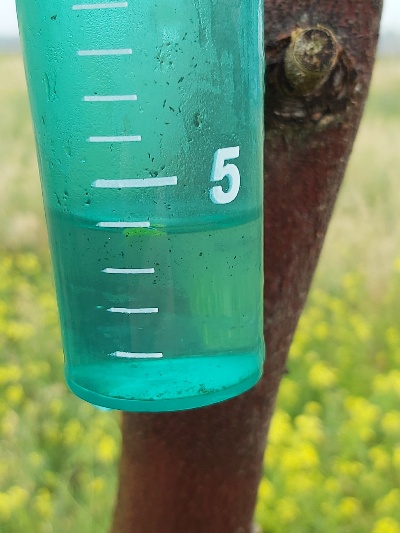
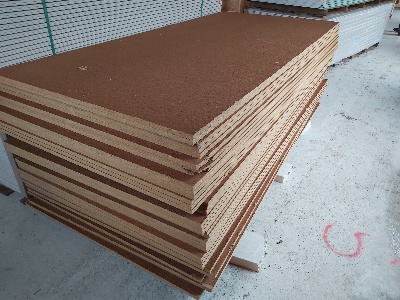 It had been raining during the day. It is difficult to know from a distance if it has rained anything at the plot, so we filled up the jerry cans and went to the new house after work. We had received four millimeters of rain in the rain gauge. I see that from 1981 till 2010, the average precipitation in De Bilt in June was 65.5 mm. We had 58.5 in our rain gauge, which means there was a shortage of 7,1 millimeters this month.
It had been raining during the day. It is difficult to know from a distance if it has rained anything at the plot, so we filled up the jerry cans and went to the new house after work. We had received four millimeters of rain in the rain gauge. I see that from 1981 till 2010, the average precipitation in De Bilt in June was 65.5 mm. We had 58.5 in our rain gauge, which means there was a shortage of 7,1 millimeters this month.
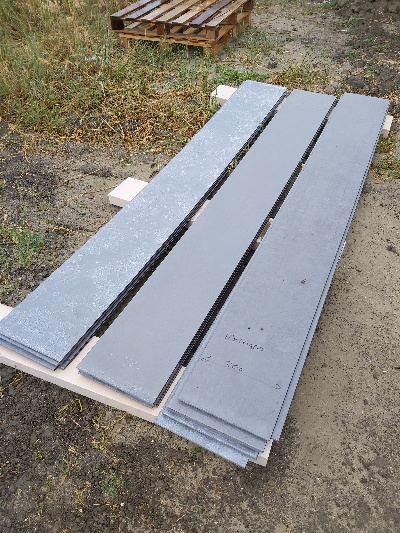 More building materials had arrived at the plot. The inner walls upstairs were finished. That is walls around the bathrooms, walls to bedrooms. No tools were lying around, and they even wiped the floor a little bit. Brown 20 mm isolation plates for the first floor were placed on a pile on the ground floor. Oh, dear! Outside they put hardboard plates for the outside of the house at the bottom of the walls.
More building materials had arrived at the plot. The inner walls upstairs were finished. That is walls around the bathrooms, walls to bedrooms. No tools were lying around, and they even wiped the floor a little bit. Brown 20 mm isolation plates for the first floor were placed on a pile on the ground floor. Oh, dear! Outside they put hardboard plates for the outside of the house at the bottom of the walls.
Talking about stairs, they took with them all their ladders as well. There was a stair section as part of the scaffold that we could use instead, so we placed it in the opening.
 I had been thinking that all purple flowers at the plot were Phacelia, but today I realized there is another beauty: Vicia villosa, known as the hairy vetch. It is also known for improving the soil. If I am not writing down the name here, I will not remember it. Once written, it is much easier to remember the plant’s name. If I still forget, I can go back to my blog and find it here. The hairy vetch is sometimes considered to be invasive. I don’t think it is a problem that we got it here. I prefer it to the thistles. Probably it is part of the green mulch mix they had growing here before we got the land.
I had been thinking that all purple flowers at the plot were Phacelia, but today I realized there is another beauty: Vicia villosa, known as the hairy vetch. It is also known for improving the soil. If I am not writing down the name here, I will not remember it. Once written, it is much easier to remember the plant’s name. If I still forget, I can go back to my blog and find it here. The hairy vetch is sometimes considered to be invasive. I don’t think it is a problem that we got it here. I prefer it to the thistles. Probably it is part of the green mulch mix they had growing here before we got the land.
Wednesday 1 July
Today we had a lunch walk for the first time in weeks. This is not good that we got no time for lunch walking anymore.
In the evening, I brought a ladder to the new house. We had that ladder at our old home to prune an Akacia tree in our garden. The ladder fits perfectly in the container. Several packages had been delivered.
Besides the ladder, I had almost all tomato plants with me. I had decided to plant them at the sea container so that I can support the plants when they start climbing. I will let them grow along with laces that I can hang down from the side of the container. At first, I was thinking I would dig a little hole for the plant and use planting soil, but in the end, I placed the plants on the ground and just supported it with planting soil from bags we bought at a garden center. That turned out to be insufficient when I started watering the tomatoes. Much of the planting soil began to erode away. Then I had to find fine-grain regular dirt to support the planting soil. This exercise kept me busy for a while. It was good to be at the house, though. Look after things. Feel at home.
A father with two kids came biking on the road. It turned out they were living in a white house in the neighboring street, and they had seen our home be built. The neighbor was pleased with the design, and when I said it was going to become red with white corners, they were delighted. I must say the neighbor was enthusiastic. The kids wanted to continue biking, they could not care less. I forgot to tell them that we were planning to keep sheep, then perhaps the girl had been a little more interested?
I kept six tomato plants at our old home. I will give them a better place to grow tomorrow.
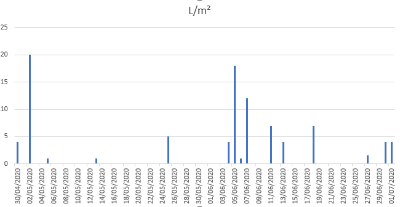 Almost forgot to say that I found four millimeters of rain in the rain gauge tonight. If it goes on like this, there will be no watering issue at all. If it just stops raining from time to time and the sun shines, then everything will be good and well.
Almost forgot to say that I found four millimeters of rain in the rain gauge tonight. If it goes on like this, there will be no watering issue at all. If it just stops raining from time to time and the sun shines, then everything will be good and well.
Thursday 2 July
Last night I could not sleep well. I already promised myself that I will also talk about feelings in this blog because if the blog is without emotions, it would be pointless. It started on Monday evening. I discovered that the building company had also delivered expensive material, 24 solar panels worth 400 euro each. That is 10K euros! They moved that into the house. The problem with this is threefold, I gave them an extra set of keys to the container so that they could place valuable things in there, and they did not do that, so that is a missed opportunity. Secondly, these things are now standing in the way in a house that cannot be locked because there is no window glass. Finally, the most obvious, they can be stolen.
I considered moving these things to the container. The problem with that, though, is that I could break a solar panel in the process, we do not want that to happen. I understand that the people that delivered the solar panels had no access to the keys etc. There must have been a good reason. As long as the house is not sealed, it is officially on the insurance of the building company. The moment it is sealed, our coverage takes over. Or it is the moment we get the house delivered. I am not sure about this exact moment. These were the things I was thinking about while I could not sleep.
There is just so much I can do. It did not pan out as I had thought. I went to the plot together with my wife, and we decided to work on securing the isolation material from rain. We moved one pallet of isolation into the container, and the rest could then be covered by a tarp. Already this was a big enough task for a midweek evening. Then we fastened all the screws holding the fence together because if you wanted anything in the house, then you at least had to unscrew the building fence.
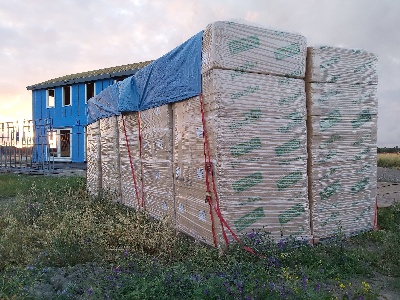
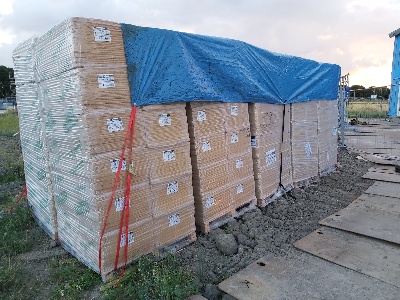 Our biggest tarp was not big enough to cover all the pallets of isolation material. We let it cover as much as possible. These pallets are otherwise packed very well. Each pallet is entirely wrapped in very sturdy plastic. Then the pallet consists of several smaller packages also covered in plastic. That second layer is not entirely sealed. It is a mountain of isolation. It is also a mountain of work to handle these packages. We realized there are different sorts, as well. Some are thicker, and some are thinner. The roof tiles, on the other hand, they are on the driveway. Now we cannot get to the end of the driveway, not to mention that the trailer of the builders, the place where they can have their pauses, is still at the end of the driveway.
Our biggest tarp was not big enough to cover all the pallets of isolation material. We let it cover as much as possible. These pallets are otherwise packed very well. Each pallet is entirely wrapped in very sturdy plastic. Then the pallet consists of several smaller packages also covered in plastic. That second layer is not entirely sealed. It is a mountain of isolation. It is also a mountain of work to handle these packages. We realized there are different sorts, as well. Some are thicker, and some are thinner. The roof tiles, on the other hand, they are on the driveway. Now we cannot get to the end of the driveway, not to mention that the trailer of the builders, the place where they can have their pauses, is still at the end of the driveway.
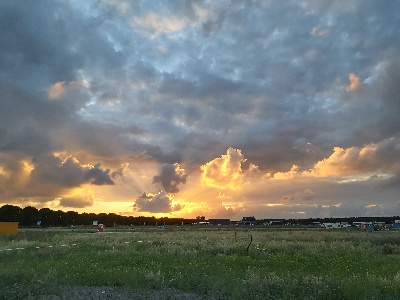 Although it had been raining at our old home, the rain gauge at the new house only had a bit of moisture.
Although it had been raining at our old home, the rain gauge at the new house only had a bit of moisture.
Friday 3 July
Today it was my birthday. My wife and son provided a delicious breakfast. During the day, the telephone chirped birthday wishes. I was working from home, and things were great.
We had talks with the builder about the roof drain. We were supposed to mount it ourselves before the roof tiles were placed. How is that supposed to be done? We bought the scaffold, but we never put one up, so it could be a good practice to do that first. Then when that was done, we could have a look at the roof drain. This was the plan. I could stop early from work and continue working later in the evening, so we went to the new house with great excitement.
We dragged out pieces of the scaffold to the north side of the house. On the ground, we placed two planks and the scaffold feet on top. The feet slide into the corner posts. We connected two corner posts with each other on the ground. Then we could raise the side of the scaffold. Next up, we connected side parts, and these were attached to the other two corner posts. So far, we had the basis. Already here somewhere, I had a feeling this was tough for my back.
Then we connected the four sides but higher up. There were also diagonal pieces that we found out how to join.
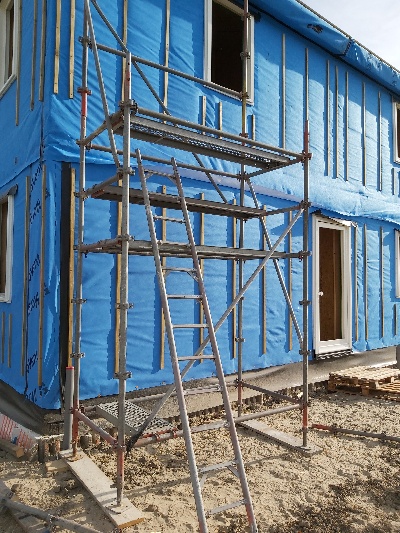 Then we started to lay out a platform to stand on. The ladders we got have no means of being fastened to the scaffold, that was a little disappointing. This is something I will discuss with the company we bought it from.
Then we started to lay out a platform to stand on. The ladders we got have no means of being fastened to the scaffold, that was a little disappointing. This is something I will discuss with the company we bought it from.
The biggest challenge was to build the next level. On the ground, it is easy to raise the corner post, but up in the air, it is difficult to aim correctly to get one corner post to slide into the next. It is just a scary operation to do so. We did it together, one held the end of the corner post, and the other raised the other end. It was not feeling comfortable to get the corners in a place like that.
At some point here, my wife got pain in her back as well. Then we stopped the building of the scaffold this evening.
A little broken, we watered the plants and went home with a feeling of defeat.
Saturday 4 July
In the morning, I got a message from the builder. He gave a price for mounting the roof drain. It was a reasonable price. We did not reply right away that we would accept the price.
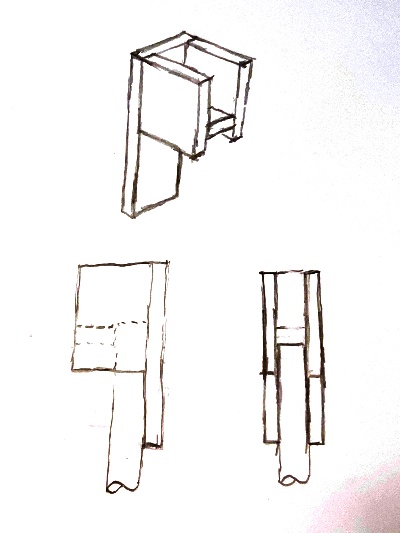 It was raining for the whole day. We decided to rest this day, especially to let the backs recover. I used much of the day to work for my employer instead. I also contemplated the challenge of fitting a corner post into the other. If I made a device that could prohibit that the pipe would fall to the side while putting it in the other tube, then it would be so much easier.
It was raining for the whole day. We decided to rest this day, especially to let the backs recover. I used much of the day to work for my employer instead. I also contemplated the challenge of fitting a corner post into the other. If I made a device that could prohibit that the pipe would fall to the side while putting it in the other tube, then it would be so much easier.
I can make it with four pieces of wood. In the sketch, the proportions are slightly off. There needs to be more wood above the end of the pipe so that then the next tube will be stabilized by this construction. Tomorrow I will have a go at making it at the plot. That means I will use the saw to cut wood, so that means I will use the power generator. There are some pieces of scrapwood available. Worst case, I will need to take a shelf from the container to make it.
Sunday 5 July
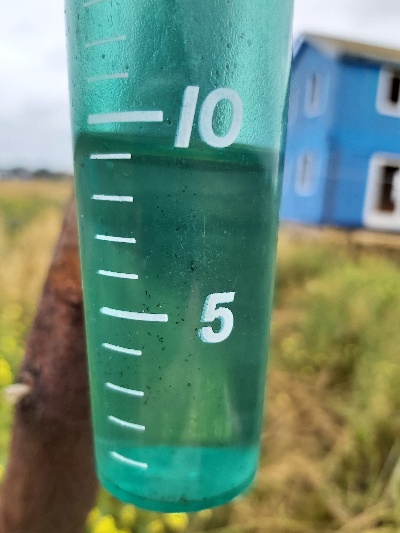 Today we went to the plot. In the UK, the storm Freya passed by, and we were getting a little bit of that wind also here. The rain gauge at the plot had collected 9,5 millimeters. The big onion had fallen over because of the wind. There was water on the floor in the house below the windows. No wonder, there is still no glass. The roof looks like it is holding up well.
Today we went to the plot. In the UK, the storm Freya passed by, and we were getting a little bit of that wind also here. The rain gauge at the plot had collected 9,5 millimeters. The big onion had fallen over because of the wind. There was water on the floor in the house below the windows. No wonder, there is still no glass. The roof looks like it is holding up well.
My main task for today was to manufacture the device that would make it possible to put up the pipes in the corners of the scaffold. For this, I had to use the power generator for the first time. I had no extension cord, so I had to stand next to the generator. That meant that I arranged a place to work outside, and the wind was strong from time to time. I had scribbled down the sketch of the device on a used envelope, and it was blowing away several times. At some point, I was done with chasing after the paper. I filled it with stones from the driveway.
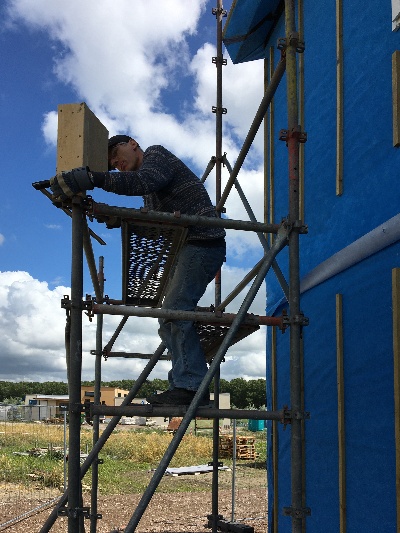
While I was working on the scaffold device, my wife planted the pumpkin plants at the plot. Initially, on 10 June, it was three pots with four seeds in each. Only two came up. What happened to the other two seeds? Were the two first pumpkin plants eating the other two? Horrible thought.
Next task for the day, we had decided to mark the spot for the future well. I talked about the well last time on Thursday, 18 June. We found a company able to come drilling for us in five weeks. This means it is about time we get our plans for our vegetable garden set out. Our idea is that the vegetable garden will be a separate part of our farm with a fence to save it from our future animals.
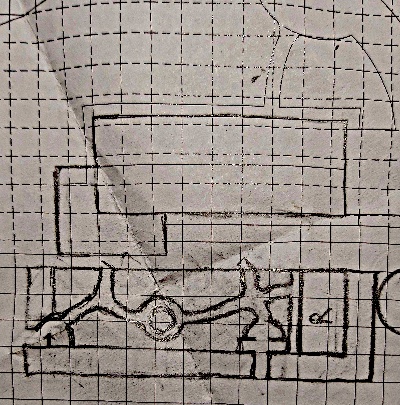 I have a scribbly sketch of the garden on a paper with a grid of 2 by 2 meters. On this sketch, I drew the patio next to the big doors. That patio is four by three grids. The well is marked with a little tiny upward arrow in the lower-left corner of the sketch. That is the west side of the plot. There will be a half-round plane around it connected to other parts of the vegetable garden with a network of paths. I call it a vegetable garden, but we will also have plants and flowers that you can dye with. At the center of the garden, there is a circular patio with room for a tree of some sort. The square part with R in it is the place for the Farmbot Genesis XL. Around the entire vegetable garden, we have bushes with eatable berries. It will be possible to enter the garden from an opening on the west side of the fence near the well, and there will be three more openings. We will create the vegetable garden from the well on the west side and onwards to the east. The robot will be one of the last projects. This means the garden will be much smaller in the beginning. One reason for this, among many, is that we planned our electricity, the Internet and regular water supply to arrive right through the east side of the garden. Besides, we have plenty of things to do in the house. Until those things are placed in the ground, we will not do anything on that part of the garden.
I have a scribbly sketch of the garden on a paper with a grid of 2 by 2 meters. On this sketch, I drew the patio next to the big doors. That patio is four by three grids. The well is marked with a little tiny upward arrow in the lower-left corner of the sketch. That is the west side of the plot. There will be a half-round plane around it connected to other parts of the vegetable garden with a network of paths. I call it a vegetable garden, but we will also have plants and flowers that you can dye with. At the center of the garden, there is a circular patio with room for a tree of some sort. The square part with R in it is the place for the Farmbot Genesis XL. Around the entire vegetable garden, we have bushes with eatable berries. It will be possible to enter the garden from an opening on the west side of the fence near the well, and there will be three more openings. We will create the vegetable garden from the well on the west side and onwards to the east. The robot will be one of the last projects. This means the garden will be much smaller in the beginning. One reason for this, among many, is that we planned our electricity, the Internet and regular water supply to arrive right through the east side of the garden. Besides, we have plenty of things to do in the house. Until those things are placed in the ground, we will not do anything on that part of the garden.
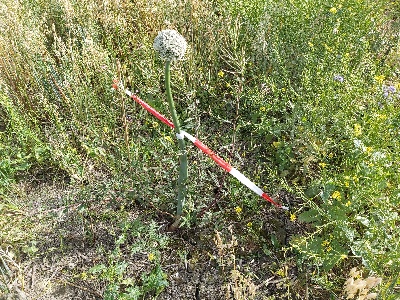 It turned out to be so that the position of the well was 30 cm (one foot) from the flowering onion. I placed a small stick on the other side of the onion and fastened it so that it would not fall over anymore. It is not so proud when it is held up by barrier tape, but it is still a grand onion.
It turned out to be so that the position of the well was 30 cm (one foot) from the flowering onion. I placed a small stick on the other side of the onion and fastened it so that it would not fall over anymore. It is not so proud when it is held up by barrier tape, but it is still a grand onion.
We were having a break at the new house when suddenly a car stopped. Out came a man saying he had precisely the same house as us, and at first, this baffled us because we have designed this house ourselves. Later he modified it as we had the same builder, same material, and some things in the design were the same. That was more like it. He was right now busy finishing his house. It was indeed interesting talking to him because he was further into the building process.
This evening we gave the builder the go-ahead for having them build the roof drain for us. Our backs had not healed just yet.
Monday 6 July
Today it was raining, and we did nothing with the new house. It was like a skip class feeling. Not that I skipped any classes at school that I can tell you how it feels. I remember I did it once, and I had terrible feelings of guilt. Since then, I did not do it ever again.
It was a good thing to stay away from the house to let our backs recover.
The feeling that the expensive things are standing in the house is something I have been having problems with. On Wednesday this week, the house will be sealed. Usually, in the last couple of weeks, I uploaded the blog of the previous week on Monday evening, but this week decided I will not post the blog for this week until the house has been sealed, and the problem with that expensive stuff is sorted. I would not like to discover that the solar panels had been stolen just moments after I posted a blog about that I really do not like having them standing there in a house that cannot be locked.
This evening we decided to spend our summer holiday working at the new house.
Tuesday 7 July
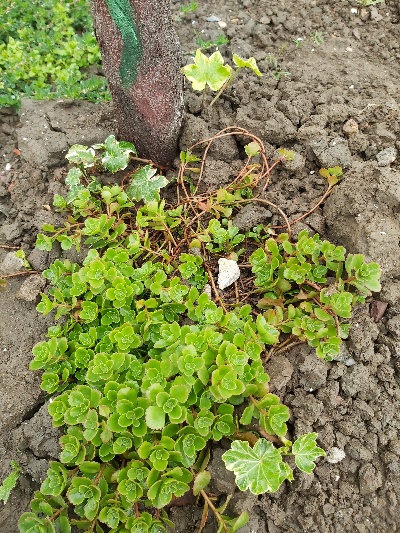 Tonight we went to the new house and sorted a few things before they will come installing the windows tomorrow. The expensive stuff was still there, it was not stolen yet. We watered the apple trees and the newly planted tomatoes.
Tonight we went to the new house and sorted a few things before they will come installing the windows tomorrow. The expensive stuff was still there, it was not stolen yet. We watered the apple trees and the newly planted tomatoes.
Not far away from the tomatoes, we have our sign that I made on 27 April. At the sign I planted ivy and today, I noticed that it has sent up new fresh leaves! We also planted Sedum Spurium, the Caucasian stonecrop. We got a carpet of these in the front garden at our old house. They will flower with purple flowers, but I have never ever seen it bloom in the old garden.
It had rained, but I forgot to empty the rain gauge, so I will do that tomorrow.
Wednesday 8 July
There were a lot of things planned for today, not by us but by the builder. I had the feeling that it was a bit much that he had planned for today. Wood would be delivered to our house. That is difficult to speak out, haha. The window glass would be delivered to the building site and mounted in windows and doors. One of the two owners of the building company would come and walk us through the delivery of the house.
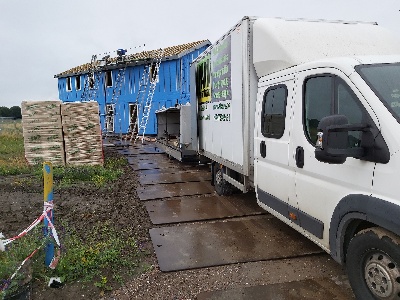 It went differently. The owner called and told me that the company delivering the solar panels was on site, and they would like to have some electricity, and since I had a generator, could they use that? Of course! I went to the new house and opened the container, and showed them how it worked. It turned out that they had a roof lift with a 1.3 kW motor, and the electricity generator could not spin the that engine. That was a bummer. They had other machines though that they could run with the generator, so it was not pointless exercise to come and help them. They came from Belgium. At first, I thought they came from a Dutch province Brabant or Limburg, but I noticed their bus had advertisements for Belgium. Any person working hard will not come from the central parts of the Netherlands. Call it prejudice, but I have not seen many examples of that.
It went differently. The owner called and told me that the company delivering the solar panels was on site, and they would like to have some electricity, and since I had a generator, could they use that? Of course! I went to the new house and opened the container, and showed them how it worked. It turned out that they had a roof lift with a 1.3 kW motor, and the electricity generator could not spin the that engine. That was a bummer. They had other machines though that they could run with the generator, so it was not pointless exercise to come and help them. They came from Belgium. At first, I thought they came from a Dutch province Brabant or Limburg, but I noticed their bus had advertisements for Belgium. Any person working hard will not come from the central parts of the Netherlands. Call it prejudice, but I have not seen many examples of that.
Anyway, one of the owners of the building company came. He held a delivery meeting with us, where he walked around the house and checked things that should be done. He also gave us instructions on how to use the different materials that had been delivered. We got a todo list:
- Inside the house, tape all open joints to the outside with green tape. On the outside of the house, if there are holes in the blue foil, tape with black tape.
- On the ground floor between the floors towards the outer wall, isolate the gaps between the stories with isolation number 180.
- Inside the house, outer walls and ceiling should be prepared for isolation. Screw 4 by 4 cm beams to the wall or the ceiling. (Actually, they are 4.5 cm square.) Start with attaching them horizontally on the floor. Where the gypsum board will end, another horizontal level will be necessary. Since the board is 1.20 meter wide, you should use 60 cm between the vertical beams. Use self-drilling 4 by 70 mm screws for the rafters. Aim for that, the shape of the gypsum board will create flags, especially around the corners of windows, etc. This is called flagging. For more info, look at the Giproc website.
- Put electricity pipes in the space between the 4 by 4 cm beams.
- Fill the gaps between the beams with isolation no 40. In the ceiling, use green tape to ensure they are staying up.
- Put white gypsum plates on top of the 4 by 4 cm beams according to the “Flags system.” On large surfaces, use 4AK plates that you can plaster all four sides of every gypsum plate. For smaller surfaces, use 2AK plates. Use white plates for regular walls and green gypsum for the bathroom and washing room. Green gypsum plates are resistant to moisture.
- Inner support walls are filled with isolation number 80. It should be possible to meet gypsum plates in most places, but if not, add extra support beams.
- Inside the house for inner non-load-bearing walls put gypsum first on one side. Add electricity pipes and ventilation where applicable, then fill with isolation no 80. Put gypsum plates on the other side.
- On the first floor, put 20 mm, isolation boards on the floor. On top of that, plastic foil and tape this to make a tight “bucket” of the entire story. In this bucket, the floor warming elements will be mounted.
- Inside the house on the ground floor, the work in the ceiling starts by applying necessary electricity and ventilation where applicable. Then mount ceiling lists every 40 cm. Then isolate in between and let the isolation rest on the ceiling lists. Then mount gypsum plates on this.
- Inside the house, before making holes for the ventilation shafts in load bearing beams, ask constructor (for permission). Rule of thumb: one-third of height etc.
- Outside the house, put hardboards at the bottom of the wall against moisture. These boards are easy to break, so be careful when handling these. Pre-drill holes and use circular saw to cut the plates.
- On the outside wall, extend the green vertical beams so that they stretch along with the whole house. On top of them, place horizontal green 2 cm thick wood beams, and on top of that, the vertical red planks will be mounted.
- On the outside, fill up with soil up to the hardboard.
- Put fascia boards at the end parts of the roof not covered by roof tiles. The fascia boards should be mounted on green beams with ventilation “waves” until the first greenwood beams, not over. This way, the roof can ventilate.
- Mount water downspouts.
This was a whole lot of information to take in. He gave us a present, a plate with delicious nuts and bonbons and cheese, etc., and he thanked us for the constructive cooperation on this project.
We asked him how he was seeing us working on the todo list and finishing the house, and he answered something that surprised me a little. He said that because we were extraordinarily intelligent, he was sure we will be able to do this. This was flattering, of course, but I understand what he is saying. What you don’t know because it is not your profession (building houses), you can compensate by searching for the answers and puzzle things together. To that, he added, “Google is your friend.” That is true.
Today we received 13 millimeters of rain!
The solar panel company mounted all the panels on the roof. With that, I will be able to sleep much better, and it lifted my self imposed restriction on posting this blog to the Internet. The transformer I moved to the container. With this, the house is empty from valuable stuff!
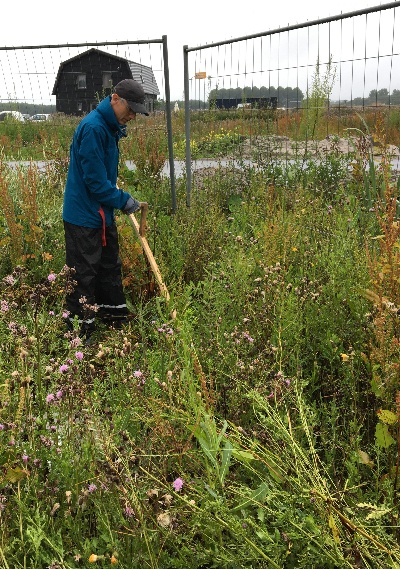
That was it. This was the difference between getting the feeling that it is a hopeless task to cut grass with a scythe but instead that it feels good. Obviously, you should keep the knife sharp. For a rough knife, it was straightforward, there you dragged a sharpener along the edge. It was a little more complicated with a grass blade, but that was for the advanced course another time. When cutting, you should let the hips turn. When moving forward, you should take one knife blades distance step each time. You were supposed to make the knife cut the grass with the sideways movement. Although the instructor said that he also cut the grass himself like a manual lawn mover. One of the students skipped the sideways motion altogether and let the knife only make lawnmower motions. He cut a lot but left us early because he got tired.
Then we went ahead, cutting the plants at this plot. It had been raining the whole day so it was wet in the grass and I had rain trousers on so after a while I was a little to warm. When I took off my rain trousers, I discovered I had a blister on my left hand! What is this, I can barely do anything, and I get back pain and a blister and what not. This is no good. I still really do qualify as an office person.
It is interesting to see how others are doing their building. The people of this plot were not at home. You could not call it home, really. It was a building site. The state of things gave me a feeling of misery at this site. Wooden beams were scattered here and there. There was underwear lying on the ground in the grass. Well, it was no grass. It was mainly thistles. The building was not closed. Window glass was missing. At the same time, I could see there was an oven in the kitchen. This area is for self-development, with all sorts of reasons that things are done in a peculiar order. We will see this ourselves. There are a few things I will keep an eye on in our own project, though, and that is that the farm looks tidy. I can also see that I will be the first to break my own rule. No, I do not want that you feel misery when you walk past our farm. That is for sure.
Thursday 9 July
Our electrician was supposed to come and have a look at the house. That did not happen. The owner of the building company told me that he sent his people to fix things on the todo list we made yesterday, but I did not go to the plot tonight. That is for tomorrow. Perhaps the wood for the exterior of the house has arrived, maybe there is window glass. Maybe the steel plates have been removed. What I do know is that it has been raining the entire day. We will get the answer to these questions tomorrow.
Friday 10 July 2020
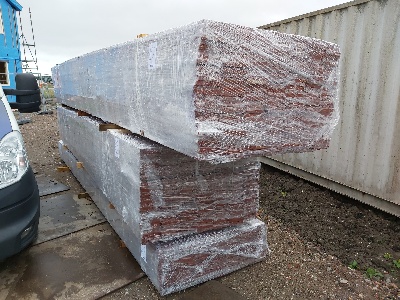 Indeed, the wood of the exterior of the house had been delivered. It was placed on the driveway in front of the roof tiles. Now we need to take each plank around the roof tiles and in the container. Also, this heap is like a mountain of work. It is packed in plastic so that it will survive rain for a little while. With this placement, it will take even longer before we can make use of the driveway again.
Indeed, the wood of the exterior of the house had been delivered. It was placed on the driveway in front of the roof tiles. Now we need to take each plank around the roof tiles and in the container. Also, this heap is like a mountain of work. It is packed in plastic so that it will survive rain for a little while. With this placement, it will take even longer before we can make use of the driveway again.
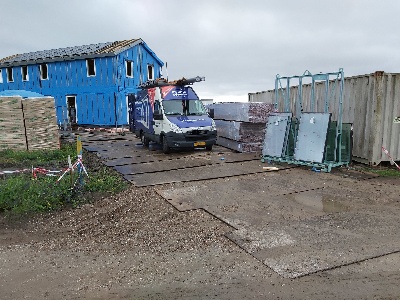 A company was busy with mounting the windows. Each window is 37 mm thick (Slightly less that one and a half inch) and awfully heavy. They called me and asked what to do about electricity. I told them I had a generator. I went to the house, and it turned out that my generator could not provide enough power for their 1.1 kW air compressor. The people at the site were not amused about the situation. Neither was I.
A company was busy with mounting the windows. Each window is 37 mm thick (Slightly less that one and a half inch) and awfully heavy. They called me and asked what to do about electricity. I told them I had a generator. I went to the house, and it turned out that my generator could not provide enough power for their 1.1 kW air compressor. The people at the site were not amused about the situation. Neither was I.
The window people had a look at the doors. The frames had not been mounted straight so that the doors would close properly. They said to me that if you install a window or door frame with a curve in it, then you are rude. They found the builders had been ignorant. It is interesting to see how different professions regard each other at the building site.
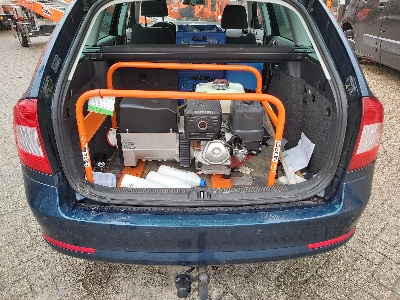 The owner of the window company called me and asked me to help with getting a replacement generator for the building site. That was a new experience for me. He sent me to a rental shop where they had all sorts of thrilling equipment. There I could pick up a more potent generator. I brought the replacement generator to the building site, and the people doing the work could start working. They had lost valuable time, though, so they could not finish their work today. They managed to put the glass everywhere so that it would not rain into the building through the windows. Also, I could lock the door, and that was fantastic. They will come back and finish the work on the glass another day. I think, perhaps next Tuesday. I noticed that one of the glass plates were broken. I am sure they will fix that next time.
The owner of the window company called me and asked me to help with getting a replacement generator for the building site. That was a new experience for me. He sent me to a rental shop where they had all sorts of thrilling equipment. There I could pick up a more potent generator. I brought the replacement generator to the building site, and the people doing the work could start working. They had lost valuable time, though, so they could not finish their work today. They managed to put the glass everywhere so that it would not rain into the building through the windows. Also, I could lock the door, and that was fantastic. They will come back and finish the work on the glass another day. I think, perhaps next Tuesday. I noticed that one of the glass plates were broken. I am sure they will fix that next time.
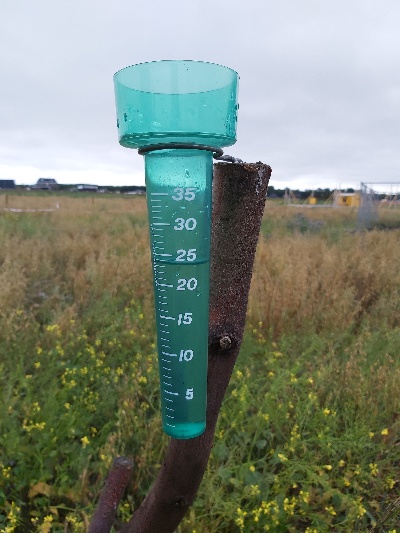 We had received a stunning 24 millimeters of rain since last time I could empty the rain gauge. The father of my neighbor Mr. AA was busy at their plot. He asked me if I had a concrete drilling machine. I have that but not at the new house. He showed me that their foundation had become a bathtub. I had noticed a ridge around the edge of the foundation. Earlier I had been wondering if there was an escape for water with that ridge. Now there was 5 cm (Two inches) of water on the floor. He wanted to drill a hole on the side to let water out. We got a water pump that is driven by a drilling machine that he could lend that from us. He also got to a spare battery for the drill. I hope he can get some water out that way. He decided to start emptying the floor with the pump.
We had received a stunning 24 millimeters of rain since last time I could empty the rain gauge. The father of my neighbor Mr. AA was busy at their plot. He asked me if I had a concrete drilling machine. I have that but not at the new house. He showed me that their foundation had become a bathtub. I had noticed a ridge around the edge of the foundation. Earlier I had been wondering if there was an escape for water with that ridge. Now there was 5 cm (Two inches) of water on the floor. He wanted to drill a hole on the side to let water out. We got a water pump that is driven by a drilling machine that he could lend that from us. He also got to a spare battery for the drill. I hope he can get some water out that way. He decided to start emptying the floor with the pump.
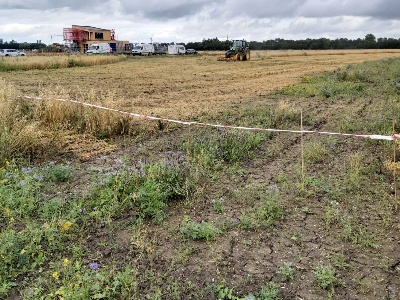 I noticed there was a tractor harvesting the grain on the neighbor’s premises next to us. As a funny coincidence, the tractor stopped his activity at the barrier tape I had set up. I thought this was a little amusing because Mr. AM and his wife had just become the owner of the plot a couple of days ago. Already earlier, I had advised my neighbor that the very exact moment he is the owner of the parcel, he should immediately put flags at all the poles so that no vehicle by accident is running over these marks. Now a few days later, a tractor is running over his land. So I sent him a foto of this, and I thought that he would reply that I had been totally correct in my advice. Indeed I got that answer but with “force” so to speak. He was in Frankfurt and could not get to the plot, and he was about to call the police to get this tractor off his ground. If he had a chance, he would call the airforce and the infantry as well, my neighbor was fuming. He wanted to harvest his own grain himself.
I noticed there was a tractor harvesting the grain on the neighbor’s premises next to us. As a funny coincidence, the tractor stopped his activity at the barrier tape I had set up. I thought this was a little amusing because Mr. AM and his wife had just become the owner of the plot a couple of days ago. Already earlier, I had advised my neighbor that the very exact moment he is the owner of the parcel, he should immediately put flags at all the poles so that no vehicle by accident is running over these marks. Now a few days later, a tractor is running over his land. So I sent him a foto of this, and I thought that he would reply that I had been totally correct in my advice. Indeed I got that answer but with “force” so to speak. He was in Frankfurt and could not get to the plot, and he was about to call the police to get this tractor off his ground. If he had a chance, he would call the airforce and the infantry as well, my neighbor was fuming. He wanted to harvest his own grain himself.
Saturday 11 July 2020
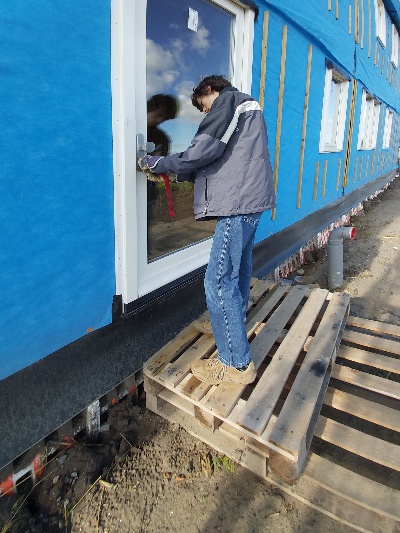 Here my son is unlocking the door for the first time. Unfortunately, I had my camera on a fisheye mode, so the perspective became a little strange. The plan for today was to move wood from the driveway into the container. You can argue that it is not the right place for wood to be stored. Time will tell. At the moment it is the best place we have for this material, out of the sun and rain. We will keep isolation material on top to prevent dramatic temperature fluctuations. Besides, the container is white, so it has a high albedo coefficient.
Here my son is unlocking the door for the first time. Unfortunately, I had my camera on a fisheye mode, so the perspective became a little strange. The plan for today was to move wood from the driveway into the container. You can argue that it is not the right place for wood to be stored. Time will tell. At the moment it is the best place we have for this material, out of the sun and rain. We will keep isolation material on top to prevent dramatic temperature fluctuations. Besides, the container is white, so it has a high albedo coefficient.
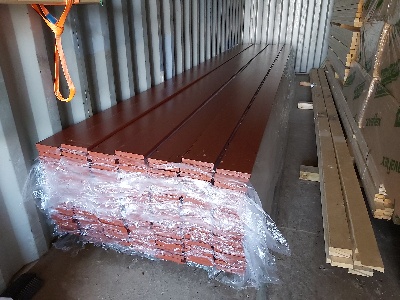 The wood was packed into three packages stacked on top of each other. Each had a sign saying that it should not be stacked. Talking about being ignorant. The sign said the material should be stored out of the sun. It said nothing about a container. I hope so much that we don’t get any problems with this plan. After unwrapping all plastic, we came to a huge surprise! Each plank was, in a way, individually packed in plastic. A sheet of foil went zig-zag through the stack of planks, and on each layer, there was plastic. They had made the foil zig-zag through the horizontal layers as well so that effectively, every plank was surrounded by plastic and a sign saying that when storing the planks, they should be stored with the plastic foil. The reason for this packaging frenzy was that the wood had been painted in red paint. RAL 3009. That is the typical Swedish color. We were a little shocked by this extensive use of plastic. Had we known this on beforehand, we had decided to paint the planks ourselves.
The wood was packed into three packages stacked on top of each other. Each had a sign saying that it should not be stacked. Talking about being ignorant. The sign said the material should be stored out of the sun. It said nothing about a container. I hope so much that we don’t get any problems with this plan. After unwrapping all plastic, we came to a huge surprise! Each plank was, in a way, individually packed in plastic. A sheet of foil went zig-zag through the stack of planks, and on each layer, there was plastic. They had made the foil zig-zag through the horizontal layers as well so that effectively, every plank was surrounded by plastic and a sign saying that when storing the planks, they should be stored with the plastic foil. The reason for this packaging frenzy was that the wood had been painted in red paint. RAL 3009. That is the typical Swedish color. We were a little shocked by this extensive use of plastic. Had we known this on beforehand, we had decided to paint the planks ourselves.
I had thought that we would go there and grab these planks and stove them into the container, and that would be it. Now we were facing a task of delicate work handling thin plastic foil. Oh well, what has to be done is done.
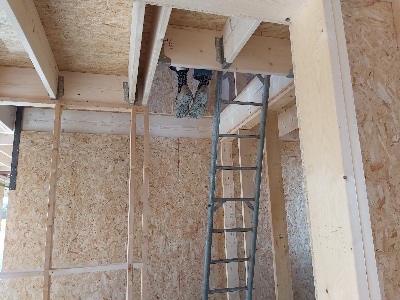 We also did other things today. Visitors came to view our house – the board of the road association came by. We could show them the unfinished house, our garden, the willows, pumpkins, apple trees, tomato plants, the giant onion, and the weather was great again. My son helped us with the planks. During a break, he checked the first floor. He sat for a while reading with his feet dangling in the hole where the stairs will be.
We also did other things today. Visitors came to view our house – the board of the road association came by. We could show them the unfinished house, our garden, the willows, pumpkins, apple trees, tomato plants, the giant onion, and the weather was great again. My son helped us with the planks. During a break, he checked the first floor. He sat for a while reading with his feet dangling in the hole where the stairs will be.

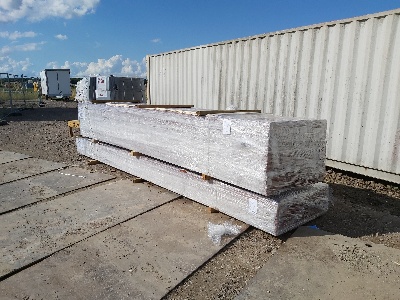 We stopped the work for the day when we had finished moving the first package of wood. I had walked 18 thousand steps today. I usually reach 6 thousand steps, and I was feeling a little less amused in the evening. I tried making a humoristic selfie of myself in the mirror, expressing my feelings. That was successful, don’t you think?
We stopped the work for the day when we had finished moving the first package of wood. I had walked 18 thousand steps today. I usually reach 6 thousand steps, and I was feeling a little less amused in the evening. I tried making a humoristic selfie of myself in the mirror, expressing my feelings. That was successful, don’t you think?
Sunday 12 July 2020
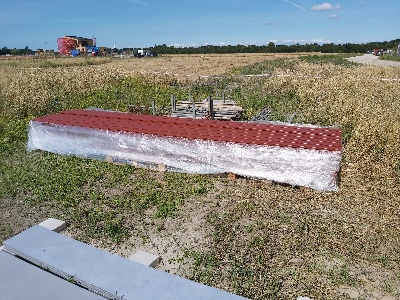 Today we had a second day working on moving the wood for the exterior of the house. We talked about the pros and cons of stacking the packages inside the container. As it stands right now, we don’t know how we are going to apply the wood, and where the different lengths will be used on each wall. If we put the wood on top of each other, we lock in our possibilities to choose later. We can protect the wood from the sun by using pallets and tarp on top of the package. We could even go for putting isolation material at the top as well. We decided to put this package outside the container.
Today we had a second day working on moving the wood for the exterior of the house. We talked about the pros and cons of stacking the packages inside the container. As it stands right now, we don’t know how we are going to apply the wood, and where the different lengths will be used on each wall. If we put the wood on top of each other, we lock in our possibilities to choose later. We can protect the wood from the sun by using pallets and tarp on top of the package. We could even go for putting isolation material at the top as well. We decided to put this package outside the container.
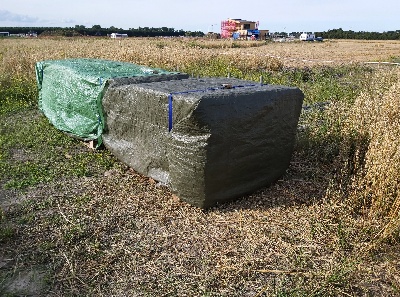 Today we simplified the process and made all planks in the same layer lie under the same sheet of plastic foil. We also carried three and then four planks in each round. Each layer had seven planks. That meant that with two cycles, we could move a layer. It was more challenging to get the plastic foil in place with the wind. We developed a technique for this. We spread the foil over the planks on the side where the wind came from, and then we had a plank ready to lock the foil in place on one side and a plank for the foil on the other side. After a while, this worked like a charm.
Today we simplified the process and made all planks in the same layer lie under the same sheet of plastic foil. We also carried three and then four planks in each round. Each layer had seven planks. That meant that with two cycles, we could move a layer. It was more challenging to get the plastic foil in place with the wind. We developed a technique for this. We spread the foil over the planks on the side where the wind came from, and then we had a plank ready to lock the foil in place on one side and a plank for the foil on the other side. After a while, this worked like a charm.
The distance we walked today was shorter 11 thousand steps, but we carried more planks each time. For me, it was more comfortable, but my wife found that it was more challenging. Midday, we took a more extended break compared to yesterday. Another difference compared with yesterday was that our son did not help us. He stayed at our old home.
More than once during this work, I was thinking how stupid it was that we could not just point at the spot where the driver would place the packages, and then we had been done with this. It had taken me 3 minutes. Now the driver put the wood on the worst spot imaginable, and we worked an entire weekend to fix this problem. The only good thing with this is that we have seen every plank in every package.
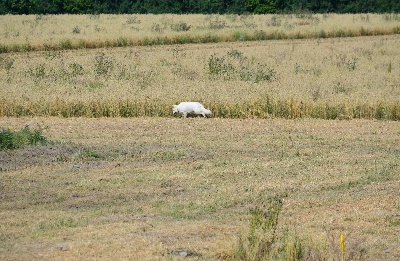
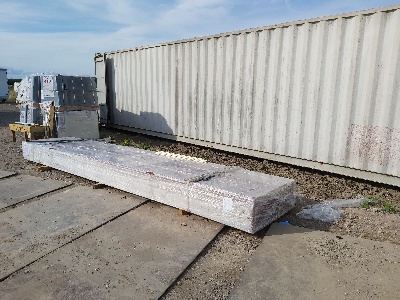 With our activities today, we had one pack of wood left on the driveway. That is for another time.
With our activities today, we had one pack of wood left on the driveway. That is for another time.
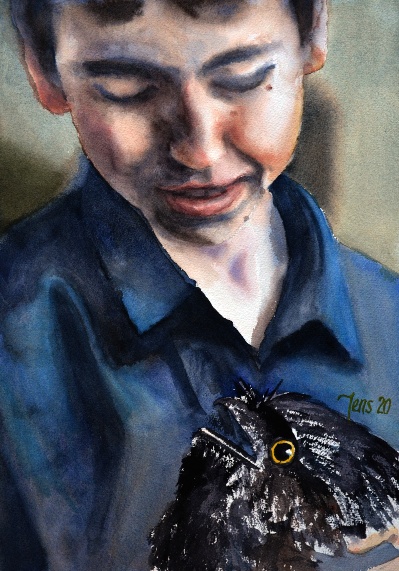
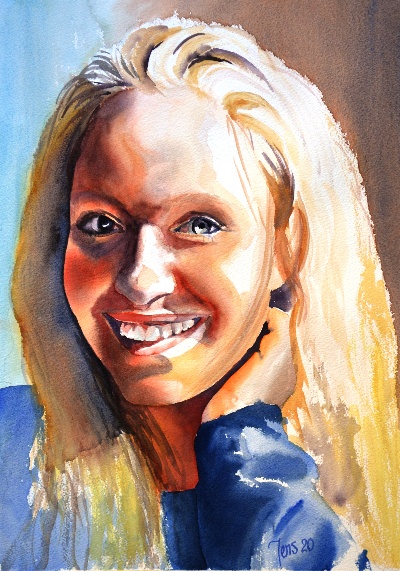
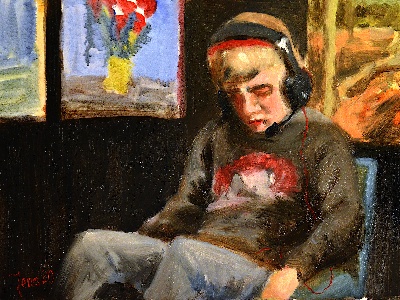
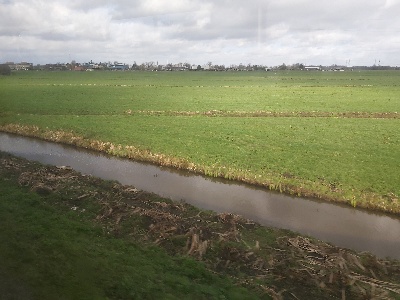

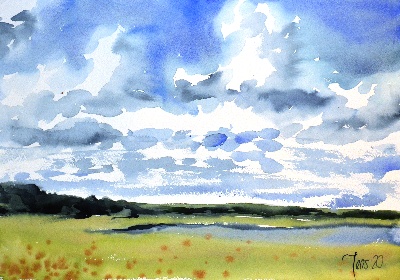

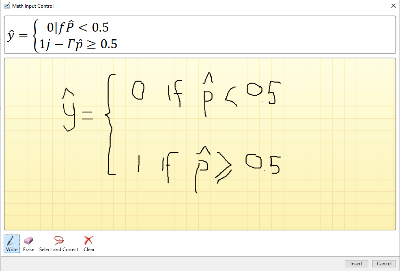
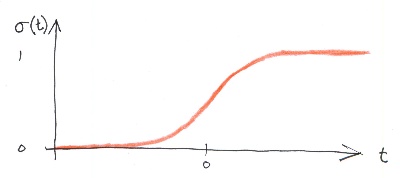
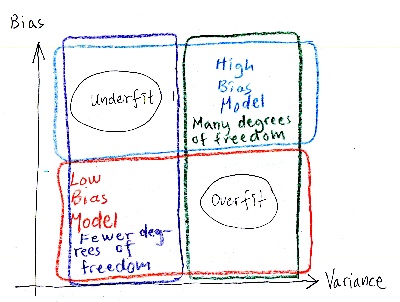
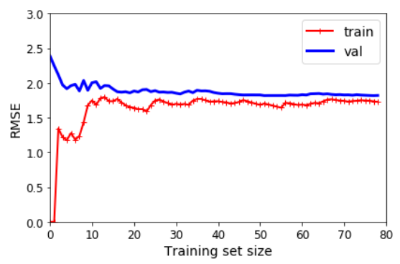
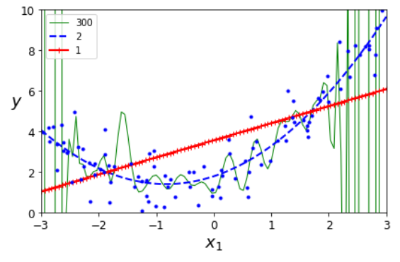


 Started insulating the barnStarted putting up planks on the north wallTried to get InternetWastewater and RainwaterWorking on the exterior this weekWe planted our apple treesStarted on ventilationMoved a pile of floorboardsWe are getting better at the gypsum platesElectricity and waterPipes and powerlinesEverything worked this weekRoof tiles and gutter finishedWe got our temporary woodstoveFinished horizontal support beams on the east side
Started insulating the barnStarted putting up planks on the north wallTried to get InternetWastewater and RainwaterWorking on the exterior this weekWe planted our apple treesStarted on ventilationMoved a pile of floorboardsWe are getting better at the gypsum platesElectricity and waterPipes and powerlinesEverything worked this weekRoof tiles and gutter finishedWe got our temporary woodstoveFinished horizontal support beams on the east side I moved from Sweden to The Netherlands in 1995.
I moved from Sweden to The Netherlands in 1995.
Here on this site, you find my creations because that is what I do. I create.